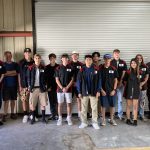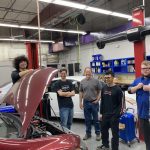
K-14 Pipelines Pave Way for College, Career Success
Career Technical Education Dual Enrollment
What’s the secret to the recent 2.6 percent boost in community college enrollment—the first bump since the pandemic, and the highest increase of any educational sector?1
It’s dual enrollment. In fact, DE students comprise 40 percent of the total enrollment increase at two-year institutions for the last two years.2
“Dual enrollment is good for the students, high schools, and colleges,” says Christina Overmiller, K-12 Pathway Coordinator serving the Sierra Community College District. Since she started her role in 2020, she’s watched CTE dual enrollment opportunities increase.
“We’re developing a pipeline of better-prepared students for transfer and industry,” says Overmiller. “Students who complete dual enrollment courses tend to be more successful if they choose to continue their education in community college or university, which means they are going to enter the workforce better skilled.”
The proof is in the research, says Tiffiney Lozano, K-12 Pathway Coordinator in the Lassen Community College District. By engaging in career education earlier, students tend to experience a smoother transition to college curriculum, resulting in faster, more consistent outcomes.
“The data shows us that if we can build that competency with students while they’re still in high school, it opens up a new path that they might not have thought was available to them,” says Lozano. “Students who complete dual enrollment classes tend to have a higher percentage of enrolling and completing certificates and degrees with good grades.”
A new push from Governor Gavin Newsom and the California Community Colleges Chancellor’s Office aims to graduate high school seniors with 12 units of early college credit by 2030. It’s a tall order, but for schools in the rural Far North accustomed to teamwork and tough challenges, hopes for success are high.
Throughout the region, schools are analyzing schedules, identifying when a college instructor can teach students from multiple high schools in order to pool resources.
“That is why the district’s schools are analyzing bell schedules for and coming up with creative solutions such as hiring staff that can be shared between the schools, hybrid classrooms and more,” says Lozano.
Strong Workforce support has been instrumental in helping establish Lassen Community College District’s growing CTE K-14 pathways, including health and human services and veterinary sciences, where industry-standard equipment allows students to practice in-demand skills. SWP also helped support Long Valley Charter School’s construction DE program by buying a property for hands-on practice.
“In this old building the school purchased, students get to touch all the systems,” says Lozano. “There’s plumbing and electrical, and they can rip out walls from the studs up to get that experience.”
Lozano says her district is just getting started with robust dual enrollment offerings in CTE pathways, and that the future is bright.
“The goal is to get students into living-wage jobs as soon as possible,” says the coordinator. “This is how we create healthy, resilient communities where students don’t have to move away for opportunity.”
Stronger alignment of high school CTE pathways with community college programs is key to making sure dual enrollment pathways represent more than just empty credits, says Overmiller.
“K-12 SWP provides an opportunity to reduce ‘random acts’ of dual enrollment,” says Overmiller. Historically, the coordinator asserts, students have taken Dual Enrollment courses as electives that weren’t necessarily helping them build real-world skills. “With K-12 Strong Workforce, now, we’re working together, high schools and community colleges, on building those career technical education skills and knowledge to prepare students for the workforce.”
At Sierra College, SWP has been instrumental in developing a new automotive program in partnership with the Roseville Joint Union High School District (RJUHSD) [read more: Fuel-Injected Futures: Unique K-14 Partnership Drives Accessible Automotive Ed]. During the day, high school students take dual enrollment classes, while Sierra College instructors teach adult education at night. DE numbers have nearly tripled since the program’s inception. 
“Our partnership with Sierra College is strong and will continue,” says RJUHSD Assistant Principal Jason Harm. Strong Workforce is currently helping the program enhance its electric vehicle and hybrid training materials to meet industry demand. “We would not have been able to put together a three-course program that gives students multiple entry points into dual enrollment without Strong Workforce.”
Meanwhile, new DE opportunities in Sierra’s entrepreneurship pathway allow learners to earn six units of college credit [read more: Sierra College Entrepreneurs Clean Up in Waste Management Competition]. Many participants are at-risk students from diverse backgrounds. Next year, students can participate through a distinctive Umoja DE cohort at Center High School. Nigel Haikins-Appiah, Sierra College Program Director of Dual Enrollment, says “it is open to all students, but we are specifically targeting Black and African American students because research shows that they face unique barriers to entry in entrepreneurship spaces.”
According to Haikins-Appiah, demand for dual enrollment CTE offerings has “grown exponentially” over the last few years at the college, especially for “students who may be uninterested or disillusioned with the ‘traditional’ bachelor’s degree route.” The director says it’s thanks to Strong Workforce that the college’s DE pathways have become so robust:
“SWP funding has been pivotal in expanding CTE offerings within Placer County DE offerings,” says Haikins-Appiah. “From curriculum planning to staffing, it has enabled Sierra to strengthen our partnerships with the Placer County CTE community.”
Dual Enrollment research points to increased high school graduation and college matriculation rates, says the director. Even better, the results “are heightened when it comes to students from historically underserved and underrepresented backgrounds.
“Sierra strives to prioritize opportunities that serve these populations.”
According to Overmiller, dual enrollment is equity-based by design.
“Many of our students don’t see themselves as college material and dual enrollment helps eliminate that myth,” says the K-12 coordinator. “Dual enrollment is one of those onramps that allow students to have the opportunity to move forward in their professional and educational path.”
According to Lake Tahoe Community College Director of Dual Enrollment Adam Eynon, CTE is the force behind DE.
“Dual enrollment really started to take off through the CTE pathways,” says Eynon. “In CTE, it is a lot easier to get an individual qualified to teach dual enrollment compared to English 101. … It created an opportunity and a model.”
At LTCC, dual enrollment has grown considerably with all three partnering high schools thanks to a COVID emergency grant braided with Strong Workforce funding. Nevada Union High School now offers 21 sections of five culinary classes, giving participants a unique head-start in a high-demand field.
“By the time they graduate high school, students are on their way to be in some serious hospitality management programs and be ahead of their peers,” says the director.
Meanwhile, South Tahoe High School offers a variety of dual enrollment opportunities, including a dental program providing real-world internships and multiple industry certifications at no cost.
“They’re not working as receptionists — interns are actually in your mouth,” says Eynon, who can attest to their proficiency, as dental students have tested their skills on his teeth. “Right out of high school, they’re qualified to step into a dental office full time, and many of them do and make pretty decent money.”
According to the manager, the key is having students practice on industry-standard equipment.
“If you go into the dental classroom, it’s mind-blowing,” says Eynon, and SWP is to thank. “This is all the equipment that would be in a dentist’s office. … The Strong Workforce grant has been so beneficial, and I don’t see how we could do a good job without it.”
According to K-12 Pathway Coordinator Dr. Lisa Kelly, “We’re getting students into the workplace faster, whether through internships and apprenticeships, but also literal employment.
“One remarkable thing that Lake Tahoe is doing vis-à-vis their great partnerships with business and industry is that it’s really stimulating more dual enrollment.”
For their part, industry partners couldn’t be happier. The high school head start is bound to come in handy as demand for reliable and qualified employees continues to rise.
As Eynon says, “Our job is to get it to grow, make it happen, and provide these opportunities and benefits to as many students as possible.”
1 Enrollments Rise After Pandemic-Related Declines, Inside Higher Ed. https://www.insidehighered.com/news/students/retention/2024/01/24/enrollment-rising-first-time-pandemic#:~:text=The%20report%2C%20released%20today%2C%20found,good%20news%20for%20community%20colleges.
2 Community Colleges Lead the Way in Enrollment Gains, The Community College Daily, https://www.ccdaily.com/2023/10/community-colleges-lead-the-way-in-enrollment-gains/
June 2024